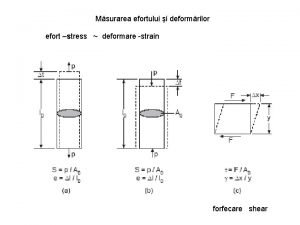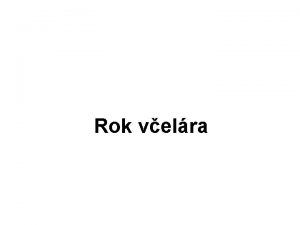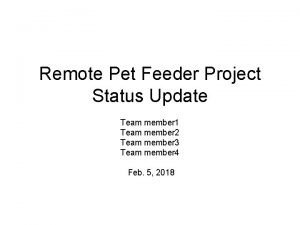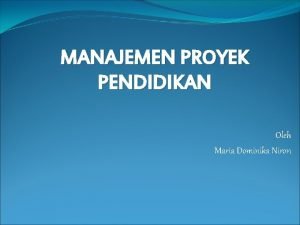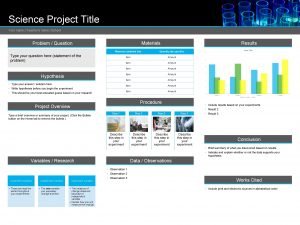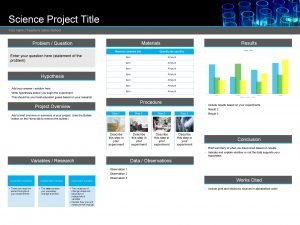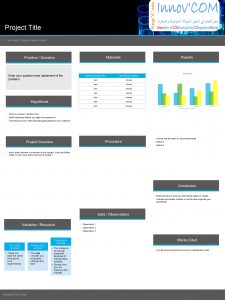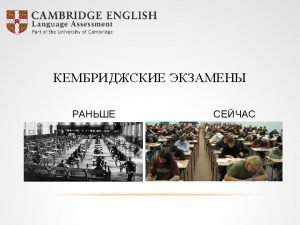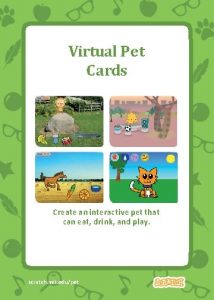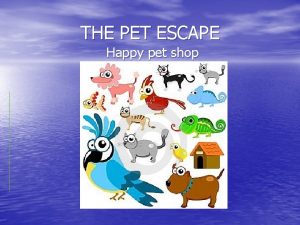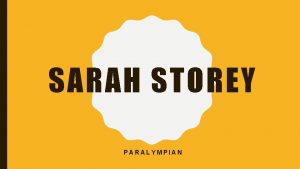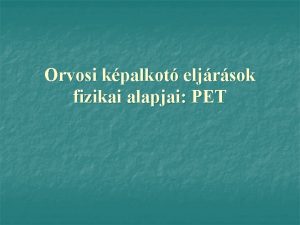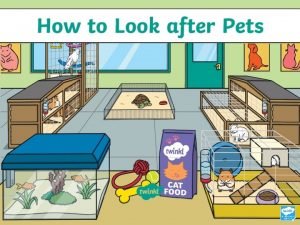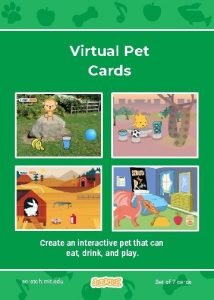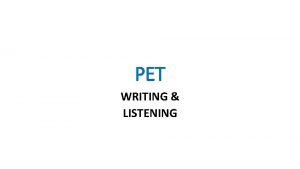Pet Project Teacher Marci Woytiuk Educational Assistant Sarah

















- Slides: 17

Pet Project Teacher: Marci Woytiuk Educational Assistant: Sarah Heit

General Information • Students who participated in the project are 3 and 4 years old & attend a half day program. • At times, the project included all 16 students in the class, and at other times, only two or three students were interested. • The project began while observing students engaged in conversation about their pets and lasted for approximately six weeks. • One student shared that his cat was going to have kittens. Once that event happened, his mom sent us a photograph of the four kittens.

Beginning the Project • Children shared that cats, dogs, rabbits and fish make good pets. However, they also thought that elephants, monkeys and sharks could be good pets. • We needed to do some research to determine, “What makes a good pet? ”

Good Pets vs. Not Good Pets • After our research, we placed pictures of animals under the headings “good pets” or “not good pets”. The students explained why they put the pictures in each group.

Dramatic Play • An invitation to the “Veterinarian Office” was set up at the dramatic play area after students shared stories of their animals being taken to the vet. • We learned about different kinds of pets & pet supplies which can be purchased at a pet store.

Our Store called “Petland” • After a class vote, we named our pet store, “Petland”. The students made signs for the store and price tags for the items in the store.

Wonders and Documentation • The documentation panel was displayed & referred to on a regular basis. • Some of the “wonders” the students had were: - what makes an animal a good pet? - why do we have pets? • Students researched what certain kinds of animals eat, where they live & learned some interesting facts about the animals.

Visits from other classroom Pets • A salamander named “Leonard” and some stick bugs came to visit. The students were very curious about what these creatures were, what they ate and where they came from. • They also wondered why Leonard’s throat moved, why he looked “slimy” and if he could make any sounds?

More Research • We researched the difference between a hamster and a gerbil, as well as, learning about rabbits and parrots. • We learned about salamanders and stick bugs after having them as guests in our classroom.

Pets from Home • Parents were invited to bring family pets to school. We had visits from two dogs and the kittens which were the inspiration for the project. • Students were able to have hands on experience observing, petting and asking questions about the animals.

Field Visit to Petland • We booked a tour at our local Petland. The pet counsellors provided many interesting facts about the animals and answered any questions generated by the students or their parents. • The students were able to interact with a variety of animals, such as: a ferret, rabbit, mice, cat, parrot, snakes and lizards.

Representation of learning • Students represented their learning through: - drawings - paintings - stories - dramatic play - play dough - constructing dog houses out of paper boxes - building gerbil mazes with marble works - creating fish tanks with art materials

Class Pet • After a discussion on what type of pet would make a good class pet, the students voted and it was determined that we would purchase a fish for our classroom. • The students were very curious about setting up the tank, getting the supplies ready and adding the fish to its new home. • He was named “Mario King” with the morning class and “Slash” with the afternoon class.

Pet Parade • To culminate our project, the students made masks to represent their favorite pet. We then went on a “pet parade” throughout the school.

Sharing our Project • Our project was shared in a variety of ways: - students’ drawings and paintings, along with the documentation panel, were displayed throughout the classroom - we visited other classrooms to learn about their classroom pets - parents were invited into our classroom along with their family pet - student drawings were displayed on a bulletin board in the hallway

Curriculum Connections • Our “Pet Project” followed the holistic approach to learning while providing many connections to the Essential Learning Experiences. Students were able to: - interact with peers through dramatic play - represent ideas and develop fine motor skills through drawings, paintings, play dough, stories and songs - display curiosity through observation and by asking questions - participate in movement activities by moving like a variety of animals to develop loco-motor skills - explore numeracy skills - develop and extend vocabulary - engage with stories & books

Reflection • I feel that the majority of the students shared a personal connection to the project which helped engage the students in learning. They were also able to learn about unfamiliar animals. • Involving parents in the trip to Petland by having them bring in family pets was very meaningful. It was a great way for staff and parents to connect, as well as the families within the class to connect with one another. Being able to provide the opportunity to the children, which they may not have had otherwise, was also rewarding. • I was hoping to have a veterinarian or someone from the SPCA come in to visit the class. However, both groups felt the children were too young for the services they were able to provide. • At times, it was difficult for students to verbally express their “wonders”. It took a lot of teacher modelling, suggesting and questioning for students to verbalize their questions.
 Marci woytiuk
Marci woytiuk Marci ryvicker
Marci ryvicker Canva com
Canva com Marca tensometrica
Marca tensometrica Včely v marci
Včely v marci Assistant teacher of gps
Assistant teacher of gps Consider gerund
Consider gerund Automatic pet feeder project report
Automatic pet feeder project report List of requirements for erf
List of requirements for erf Good afternoon dear students
Good afternoon dear students Contoh proyek di bidang pendidikan
Contoh proyek di bidang pendidikan How to write teacher name in project
How to write teacher name in project Simple past arrange
Simple past arrange How to write teacher name in project
How to write teacher name in project How to write teacher name in project
How to write teacher name in project How to write teacher name in project
How to write teacher name in project Starters movers flyers
Starters movers flyers Create a virtual pet
Create a virtual pet



